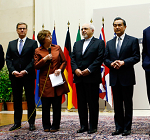Sometimes an ill wind appears to blow somebody some good. The emerging perception in parts of Europe, notably the United Kingdom, and in the United States that the Islamic “caliphate” stretching from the north west of Baghdad to the north east of Damascus is now the greatest threat to their security, looks like a stroke of luck for Iran.
It has already induced the British government to re-open its embassy in Tehran, as well as provoked a fierce debate in Washington – between foreign policy realists who recognise the case for working with Shi’a Iran to stem this latest threat from Sunni fundamentalism, and pro-Israeli ideologues, who abhor that idea.
But Iran’s president and foreign minister are too wise to be relying on this sudden coincidence of interest with the West to resolve their long-running nuclear quarrel with the U.S. and Europe.
Instead, they are continuing to implement, scrupulously, their share of the commitments laid out in the Joint Plan of Action, agreed on 24 November 2013 with the U.S., UK, France, Germany, Russia and China (E3+3), to cooperate fully with the International Atomic Energy Agency to resolve that agency’s remaining concerns about past nuclear-related activities, and to negotiate constructively with the E3+3.
That negotiation is due to climax on July 20. What is billed as the final round of negotiations got underway in Vienna on July 2. The aim is to produce a “comprehensive solution” to the nuclear dispute, leading to the lifting of both, multilateral (UN) and bilateral (EU and U.S.) nuclear-related sanctions, and to western acceptance of Iran’s nuclear programme as fully compliant with Iran’s obligations as a party to the Nuclear Non-Proliferation Treaty (“normalisation”).
The most difficult issues that confront the negotiators are:
*the number of centrifuge machines that Iran will retain during an interim period between the conclusion of an agreement and “normalisation”, and the length of that period;
*pace and extent of sanctions’ relief during that period;
*whether Iran will complete a small reactor at Arak that could be used, the U.S. and EU fear, to produce weapon-grade plutonium; and
*will Iran accept restrictions on the development of missiles “capable of delivering nuclear weapons”.
There is some reason to think that the Arak reactor problem is well on the way to resolution. The head of the Iranian Atomic Energy Organisation said on 11 June that the AEOI is working to reduce the designed output of the reactor to less than one kilogram of plutonium a year. At least five or six kilograms are needed for a nuclear device.
It also seems possible that the U.S. and EU will accept Iranian assurances that they are not developing, and do not possess missiles capable of delivering, nuclear warheads. The situation is obscure, but the evidence for Iran having sought to develop a missile-deliverable nuclear warhead is questionable, and there is no evidence (for instance in periodic assessments by the U.S. national intelligence community) that any such Iranian research has been successful. Producing a warhead small enough to fit atop Iran’s medium and short-range missiles would pose a technical challenge.
By far the thorniest problem on the agenda is the centrifuge problem. Calculated leaks have suggested that the Iranians are bidding to add to the 16,000 centrifuges installed at their industrial enrichment plant near Natanz, and to operate many more than the 9000 currently in operation, so as to be able to supply fuel to their first power reactor at Bushehr after 2021. The U.S is insisting that Iran cut back the number of operational centrifuges to 4000, or even 500 in one account, for many years to come.
Cutting this pear in two and compromising around some mid-point has been rejected publicly by the U.S.-most recently by U.S. Secretary of State John Kerry on 30 June. Is the U.S. bluffing? Are both sides engaged in a game of chicken? Or will the negotiation fail on account of the U.S. obsession with denying Iran a capacity to “break out”, despite there being no sign that Iran is contemplating such a self-destructive move?
The U.S. defines “break-out” as the ability to produce enough weapon-grade uranium for one device in under a year. However, both the concept and the definition have been contested by some nuclear experts.
The U.S. negotiators are hampered by the continuing hostility of many senators and representatives towards Iran. It looks improbable that any administration can persuade Congress to repeal relevant sanctions legislation any time soon. So the U.S. approach smacks of “asking for the moon and offering peanuts”, as an Iranian diplomat once said.
Few who have followed the politically fraught evolution of U.S. policy on this issue are likely to feel confident that yet another resolution opportunity is not about to be missed.
Ambassador Peter Jenkins is a former British diplomat who worked on the Iranian nuclear issue when ambassador to the International Atomic Energy Agency in Vienna (2001-06).
This article was exclusively written for Gateway House: Indian Council on Global Relations. You can read more exclusive content here.
For interview requests with the author, or for permission to republish, please contact outreach@gatewayhouse.in.
© Copyright 2014 Gateway House: Indian Council on Global Relations. All rights reserved. Any unauthorized copying or reproduction is strictly prohibited


